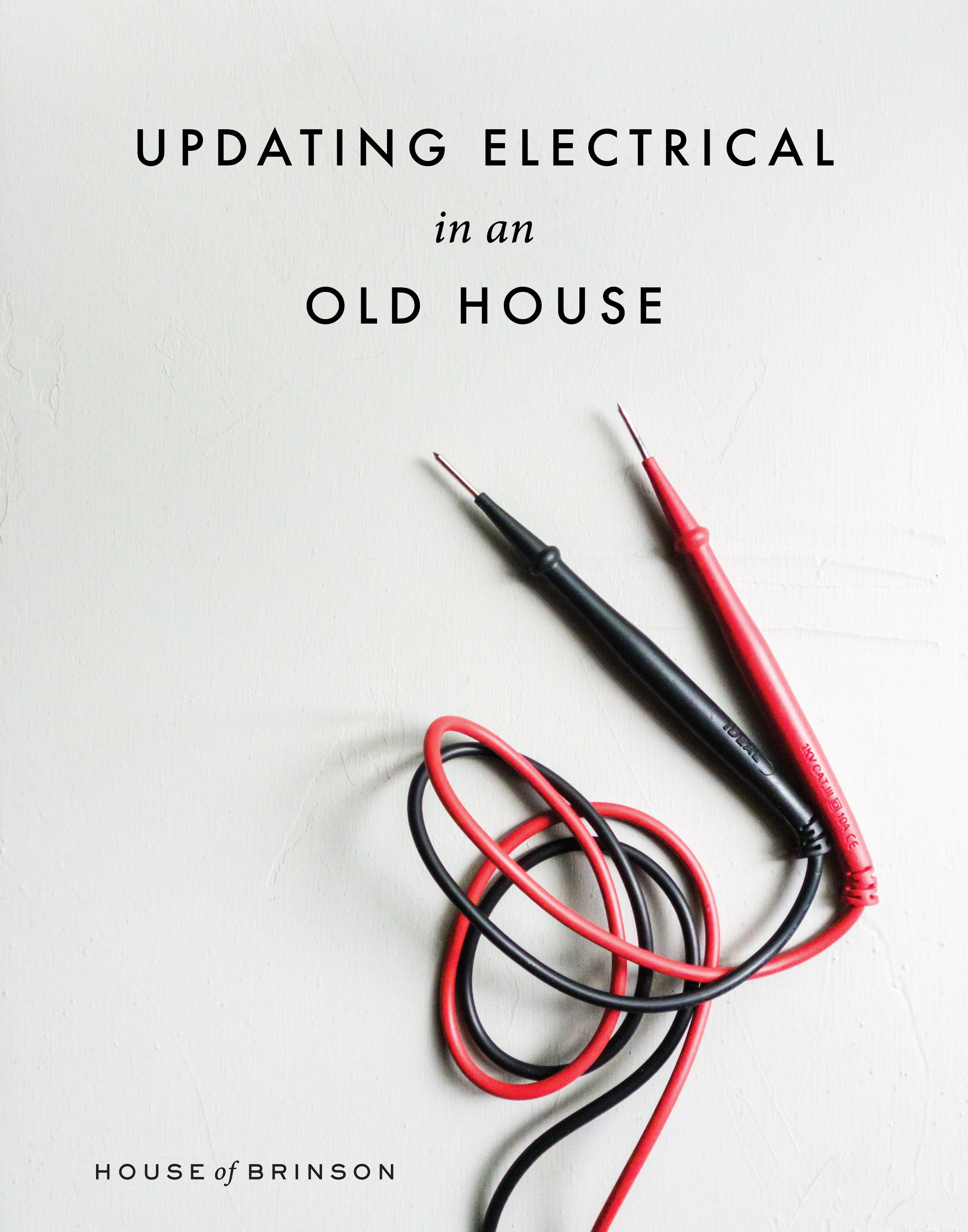Updating the Electrical in an Old House
We did it. We updated our electrical. What had been years of anxiety and a vortex of unknown is done. And it was way less painful that my imagination said it was going to be. Our house is from around 1850 and we were scared, mainly because we had people telling us so many horror stories! We’ll take you through what we learned and hopefully it helps you on your journey. If you’re an old home owner, and have had your electrical updated, please share your experience in the comments.
First I’ll say, I’m no expert in electrical nor an electrician. I’m a first time home owner who bought an old home without fully understanding how electrical in old homes work. Let me paraphrase my understanding of how electrical came to be!
In the late 1800s electricity was being installed in luxury homes, but was powered by a generator. The light bulb had been invented, but the biggest challenge was how to deliver the power into the homes and buildings. I read a book called The Last Days of Night, and it describes the race to network electrical distribution. Once available, you can imagine how electricity changed society.
Knob and Tube
No, our house doesn’t currently have knob and tube, which was the first wiring style used in homes. Everytime we tell someone we have an old home, people ask us this. It drives me nuts. I think knob and tube got a bad wrap. It’s a well designed system and when used properly and undisturbed, it works well. Key word there: undisturbed. Every historic chat group and board mentions how each generation of homeowner has work done, changes made. So if your house has knob and tube, there’s a possibility it’s been modified and that’s where the trouble sets in. If a mouse chews a wire, the wires are just open in the wall, or if something is loose, moved, whatever, the wires are just loose. Here’s a video showing how knob and tube works and what it looks like. If you have an old home or are thinking of buying one, you’ll know what to look for after watching the video. Our home does have evidence of old knob and tube. We even have ceramic wire nuts in some of the rooms!
The best fix for knob and tube is to rewire the house. Meaning your electrician will have to knock holes in the walls to install new wire. It can be messy and costly to have repaired. Best to know before you move in, or begin major renovations so you can deal with it first. Some people would debate having to rewire the whole house but if you ever want to sell the house, it might not pass inspection, or with modern appliances being energy hogs, do you really have enough power in the house?
Our house was updated to BX sometime in the 40s – 50s, which is really great. Just the panels and some distribution was outdated. Here’s what we fixed:
We have four panels in our house: two in the basement, second floor and third floor. The second and third floor were glass fuses and those were what we really wanted updated. In NY state, some home owners insurance companies will not insure you if you have glass fuses. Not that was a huge deal for us, but good to know if you are considering purchasing an older home. Funny to me, when we had our house inspected, the inspector mentioned our newer fuse box in the basement had been recalled – and we should replace it eventually. That was a bigger deal than older panels. Another factor that was making us crazy anxious to upgrade the electrical was the fact we only had 100 amps coming into a 7,400 sq ft of usable space. Most residences have 200 amps. Here we are with this huge house and very little electrical coming in. We were always blowing the power left and right. Another factor was if we ever wanted to add safety measures like GFCIs to the bathroom or kitchens, we’d need to update those fuse boxes. Our bathrooms and kitchen are in sore needs of updates, and things like a simple plug was a total fantasy unless we addressed the whole system. We’d also like to update the third floor, which has very little electrical. And the electrical that is there looks like it was installed rather sloppy? Yes, I’m judging.
We started with the foundation work
We had all our panels updated and the downstairs bathroom rewired/updated, and the upstairs master bath rewired/updated. This is what we’re calling Phase 1! Whooot! Completed. It was not as traumatic as I thought. And: I can safely plug in a blow dryer. I know, the excitement. Calm down now Susan! We also upgraded to 300 amps, so as we make additions and changes throughout the years, we’ll have plenty of amps to work with.
Here’s my advice if you need to have electrical work on your old home done:
- Find a really good electrician. Like really good. Make sure they have experience working on old homes and are licensed.
- Make sure your electrician has experience working with plaster walls. When we interviewed electricians, one said they were going to cut horizontal channels in our plaster walls. Ummm, no. Uhhhh, the plaster walls will FALL DOWN if you cut horizontal. Moving on. I am AMAZED that we had not one hole in our walls from running new wire. That takes talent. NOT ONE HOLE.
- Beware of alarmists. These are the people who make it seem like end of days if your house wasn’t built in the last 3 years. I’m so over these people and have found they have no idea what they are talking about 98% of the time. If someone says something to you that sounds off, research it. Ask a professional. That said, I’ve talked to professionals that are alarmists too. Beware. There should be a practical solution for most problems.
- Ask your electrician how they will approach the project. This was super helpful during the interview process and helped us understand the work ethic and personality of the electrician, and helped the electrician ballpark how much time it would take to complete the job.
- Ask a lot of questions, even if they are dumb. It’s your house, your money and your responsibility. I have no shame. I will ask away, etc. Ask how destructive the process will be to the house. Keep in mind the electrician might not be able to give you a complete answer until they get in there, but ask for a ballpark. That allows you to understand if you need to hire a second person to come in and do the walls, or other repairs.
- Ask what the process and timeline is like. We had one day where a team of electricians installed all the new panels, and we were only out of power for a few hours. Then we had a second day when they did the ‘hot cut’ and rewired the power coming from the street (from 100 amps to 300 amps). We addressed the bathrooms at a later date.
Now we have the foundation to make continued improvements to our home – we upgraded to 300 amps. We can update as we go, making for smaller projects which is way friendlier to our pocket book. We’re also primed for a kitchen renovation, which will require completely rewiring that room. Yikes! This projects checks one big items off our renovation list.
If you’ve rewired an old home, please share your experience in the comments. Old homes are so unique, I find everyone has a different experience.




Hey cuz-in-law! We live in an old home (1948) that seriously needs all its electrical ripped out and three-prong grounded electrical sockets put in. We only have a small handful of grounded “modern” sockets in the entire house. I just forwarded this post on to Jonathan, too. Thanks for the great info!
Laura
We have a 1920s home in Long Island where most people gut plaster walls and old houses replace everything. We love our plaster walls but 2/3 of our house was still knob and tube. (Both the previous owners and the inspector told us 100% of the knob and tube had been replaced – Get an inspector who knows old homes and dont trust your seller.)
We found an electrician who was experienced with plaster and we did end up with a fair amount of small wall holes but I think he minimized as much as he could. He was well known in town and as far as I can tell did a great job. It cost us about $6000, which was thankfully less than the $10-15k we had guesstimated based on tv shows and internet research.
We did not have him patch the holes -we figured he’s not a plasterer. We’ve been slowly patching and painting ourselves. Hope this helps others!
My house is a 1942 ‘war box’ build for Boeing worker housing. It had knob and tube, and the 1970’s addition had whoknowswhat but the mix was problematic for insurers. My story is about the holes in walls. My house is one story with a hipped roof and the older part of the house was untouched outlet-wise. Rewiring in my area required adding many, many outlets to meet code – many on exterior walls – thus, many holes. There is no rewiring without holes in this instance, unless the electrician is a graduate of Hogwarts. In my search, not one electrician revealed the hole-making that was necessary (two for each outlet on an exterior wall) and the further necessity of hiring a good drywall person to make repairs if you are not handy yourself. Part of the problem was my lack of knowledge required to ask specific questions. It never occurred to me that holes would be necessary because it hadn’t been for friends or family. Research, ask direct questions, check and re-check the answers.
We had our electrical wires replaced a few years ago in a 1925 house with original wiring (+1 outlet added in the living room floor about 40 years ago, +1 outlet I added to the kitchen but on it’s own breaker, and +2 outlets added in the basement to power a washer and dryer – there was existing power for these but on opposite walls). My main reason for having the wires replaced was so I could renovate the kitchen and bath and attic and add a few outlets without worrying about causing damage to the existing wires and because the outlets and lights were grouped on only 2 breakers so we had to be careful not to watch tv and cook breakfast and vaacum at the same time. The service had been upgraded to 200 amps and the panel upgraded to breakers before we bought the house so we didn’t have to add that on.
I waited many years to save up money for this project because it knew it would be expensive and the house needed a new roof and new furnace more than it needed upgraded wires. The first quote I got was for $30-40k and we live in a 5 room bungalow. I freaked out, started wondering how I was going to take out a home equity loan to pay for it because I hadn’t saved that much and come Monday morning I realized thanks, but no thanks we’re not going to pay that. I got a recommendation for another electrician and got a estimate for time + materials for the job. They told me they had an old house guy that specialized in updating electrical and he did the whole job by himself except for one day that he had someone help pull wires to the attic. I provided an extensive list of exactly what work I wanted done: detailed list of number and location of new outlets, specified GFCI breakers for the kitchen and bath (so I didn’t have to have square GFCI outlets), requested a whole house surge protector, specified no outlets around the exterior walls (we have brick masonry walls and I don’t want conduit and wall mounted boxes that stick out into the room. I did get 2 floor outlets in the living room for lamps), and specified that electrical service to the attic would need to some day support a heat pump or AC/heat. We also elected to add wired smoke detectors to the attic, bedrooms and hall.
The electrician called me before cutting each hole in the wall to make sure the outlets were going exactly where I wanted them and I mentioned before he started that I didn’t care if he had to make holes in the kitchen or bath since those walls would we worked on/tiled later. We tore out the ceiling in our basement (why did they put up a lathe and plaster ceiling in the basement!) to give him access and most of the wire was run up and down into the walls from the basement. It means a little more wire is used but a whole lot less cutting into walls. There are two holes in the ceiling in the hall that were necessary to get around the stairs that I will patch someday, an extra hole in the kitchen where he tried to place an outlet and encountered the original hot water heater pipes from when it was located next to the range, and the switches were moved over 9″ in the bathroom because the cold air return was covering up the access to the original switch location. I think there might be another extra hole where access to an existing outlet was also blocked by a heating duct and so the new outlet is 2″ over but it’s behind a dresser so I don’t see it.
I kept the original push button switches with the intention of reinstalling them after our inspection but later noticed some burn marks and melted spots so instead I waited for a sale at House of Antique Hardware and bought new push button switches. We kept all the original light fixtures too but many of our lights were essentially bare bulbs in a ceramic socket screwed to the ceiling with a brass and glass shade installed over it. So we now have new bare bulbs on our new ceiling boxes that I will someday screw the fixture/covers back up. Nearly all of the lights were painted with wall paint at some point. I have a feeling that they were painted brass fixtures, cream or brown maybe, and the previous owners wanted to brighten them up with white paint. When I stripped the paint from the brass the original finish came off also but I’ll probably keep them brass even though the kitchen and bath fixtures are chrome.
The final cost for the job was slightly under 10k and I felt it was a very reasonable price for the work that was done. I didn’t replace the wiring because I think that knob and tube wiring is dangerous and would burn our house down, but I did want to add insulation to our attic and add more outlets and arrange the outlets over more breakers so we weren’t tripping them regularly.
I like your post and I am happy to share this post to my friends.The post Contains Really Lot of valuable Information updating-the-electrical-in-an-old-house.I really Gathered lot of information Form your Post
I had fun reading your post, It was worth reading for, I think I need to ask my husband to check our electrical since it has been checked for almost 5years. Thank you for sharing your story!
My husband and I just bought an 1850’s home and are daunted by the task of updating the electrical. We are definitely not professionals, but it doesn’t take one to see what a mess the house is in this regard. I really enjoyed reading this article and am going to take the advice to heart. I’ll let you know how it goes when all is said and done!